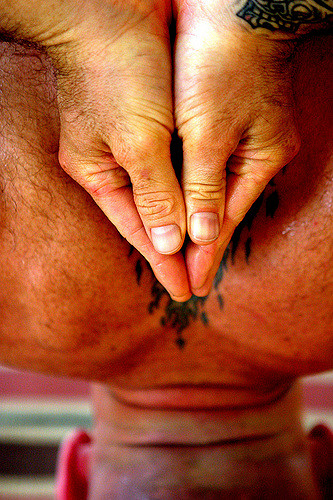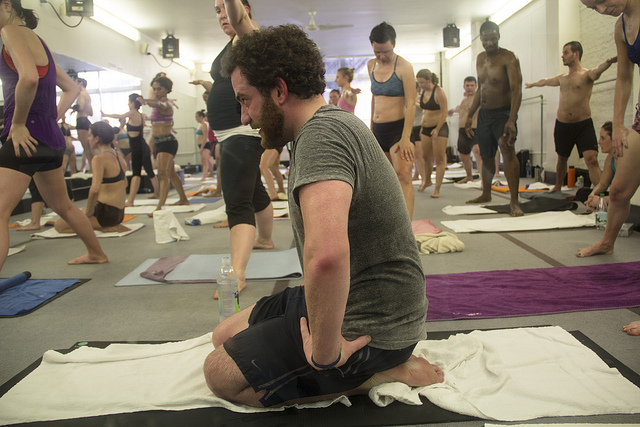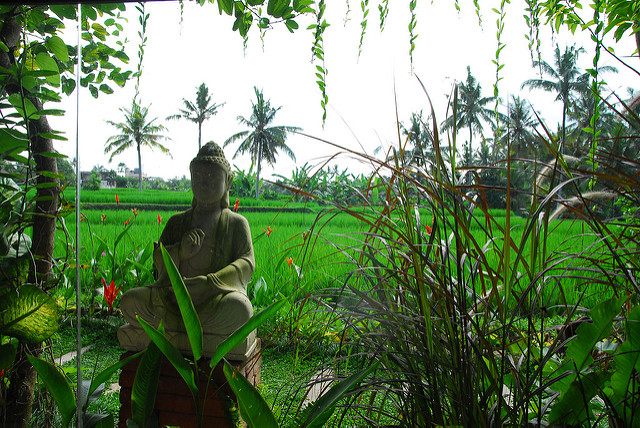
“I want to go to Bali to get certified to teach Ashtanga.” The young lady, with a lanky, lean, fit body with shoulder length dark hair, was telling her friend over a cup of Starbucks coffee.
I was sitting at the same Starbucks enjoying a green tea latte when the comment sparked a memory of a conversation I’d had a few days before with my teacher and friend Anthony “Prem” Carlisi.
Prem runs the Ashtanga Yoga Bali Research Center, and has been practicing Ashtanga since 1978. He has seen yoga go from obscurity to stardom. (Have you seen the new McDonald’s commercials, where the yoga teacher tells the students about their new meals?)
I just happened to overhear the comment. They had been talking about yoga for some time already. They shared how they love going to different classes, and whether they would go to Wanderlust or not.
Back in 1979 when Prem went to Mysore India to study with Pattabhi Jois, these kind of conversations were rare. In fact, when I found Patanjali’s Sutras back in 1994 at the library of the University of North Carolina at Chapel Hill, the word yoga was not even a common term.
On one level, it speaks volumes to the power of yoga that in just over 40 years, it has become a daily conversation, and almost everyone has heard of it, even if they think yoga is just about touching your toes. On the other side of the coin, it is interesting to see how yoga has also become a fad, with people claiming themselves to be “yoga teachers.”
The controversial teacher Osho in a sense predicted that this would happen, as much as he predicted that growth of yoga in the West would mean growth of lifestyle in India. Also the “Great Master” (Sawan Singhji) as he was called from the Punjab, predicted back in the early ’50s and ’60s the new revolution of spirituality will be in the USA. Paramahansa Yogananda also envisioned this back in the early 1900s.
Between the internet and the overwhelming popularity of yoga in the USA, these predictions came true.
Yoga has become so common in the West, that when you look around it seems every third person is a “yoga teacher.” Or has gone to a yoga teacher training program.
It has helped thousands find happiness, health and a new lifestyle. With the huge rise of social media, some teachers have become celebrities simply because of their regularly posted images. It is incredible and alarming at the same time. Like the Charles Dickens book says, “It was the best of times. It was the worst of times.”
Standing in front of others, and guiding and supporting them through an activity is one of the most rewarding, emotionally fulfilling activities one can do. It is service—doing something you love and sharing it with others. How can that not be incredible?

That’s why the hot yoga style popularized by the polarizing personality of Bikram Coudhury has been the most successful at spreading the healing power of yoga.
Today most hot yoga classes are a dialogue based sequence class, which is easy to replicate and teach others. In these yoga classes, held in a 105 degree room (40 degrees Celsius) the instructor learns a dialogue and the challenge is to stand in front of others and deliver it. The dialogue is filled with precise “instructions”—a script filled with humor, insight, and philosophy. All the student has to do is “memorize” it, and then stand and deliver. A newly graduated teacher from a “teacher training,”—someone who started their yoga practice just a few months before—is leading people in a class.
The average cost of a Yoga Teacher Training program is around $3,000, making teacher training programs a lucrative business for yoga studios.
“It’s the power of 200hr Yoga Alliance,” Prem, with his beautiful, long, grey beard was thinking out loud when we were chatting at my apartment in Newport Beach, CA. “It has created such a business and a slew of people getting other people to move and breathe. Which is actually really amazing! But at what cost?”
Prem runs the Ashtanga Yoga Research Center in Bali, and along with his wife Radha, they focus on sharing the “authentic” path of the Ashtanga tradition.
Ashtanga unlike hot yoga, or most modern yoga today (which is led class based), is practiced on your own, in a room with others. You “memorize” the sequence and you practice (ideally) every day except for Saturday, new and full moon days. There are reasons for these suggestions. It’s not random! The practice is thousands of years old, and for those who practice regularly, will find it leads to a long and healthy life. (Prem looks like he glows after more than 40 years of daily practice).
In Ashtanga the intention is to learn the practice, and the practice is simple.
The practice is to follow your breath.
The fun part is that we get to take the body in different poses that free the range of motion in the spine, hips and all other major joints in the body. It tones all the internal organs. If done correctly, it safely opens every area of the body and mind. There must be the expert guidance of a well seasoned teacher to facilitate this for the student in order for it to be effective. Like anything in this world we need to be guided by a “qualified” teacher. Yoga is no different!
In Ashtanga there is a specific way to move between poses. That’s the practice. It is called “vinyasa krama.” And then one can do it at home alone, or in a room with others while a teacher walks around and provides physical adjustments and corrections—which allows the student to be empowered to carry on for a lifetime. The teacher can tell how well the student’s breath is regulated. Once the student learns how to keep the regulation of breath along with feeling what is correct for their unique body and mind, then the sense of community and the daily adjustments are the biggest source of support and progress for the student.
I remember moving from Encinitas, CA to Tucson, AZ after almost two years of daily practice with Tim Miller. Tim and Prem were roommates when they first started their practice back in the ’70s.
While I was practicing by myself for a few months before meeting Tim, the two years I spent going daily to his studio truly helped me establish the morning habit of getting up and doing yoga. His adjustments opened my body in ways that I could not imagine. In some sense that is the draw to Ashtanga—that your body and mind open, expand, and are filled with energy or prana all day long. Getting daily adjustments, and seeing others struggle or flow with their breath was educational in ways that cannot be taught in a modern day yoga class environment.
So during my last practice with Tim, while he gave me an adjustment, he asked: “Are you still going to practice every day?” and I answered: “I was practicing before I came here, of course I will still practice.” Tim smiled and then he told me: “Practice with adjustments, progress is quick. Practice with no adjustments, progress is slow.”
Having been traveling and teaching for almost 10 years and mostly practicing daily on my own, I know his words are true.

So, Prem and Radha run a traditional style school, where students practice in the morning and they get “adjustments” specifically for them, and you have to sign up for at least a month.
This has been the method since the early days with Guruji (Pattabhi Jois of Mysore, South India—Prem & Radha’s teacher).
That’s how Ashtanga would ideally be taught.
But of course, it is popular in the West, and there are many classes called Ashtanga, where the teacher guides poses and tells students to ujjayi breathe. And then you get to overhear conversations: “I want to get certified to teach Ashtanga.”
Today you can in fact Google and find many Ashtanga yoga teacher training programs. Even though technically the only way to get a certificate of authorization is through the grandson of the man who spread Ashtanga, the great Sri K Pattabhj Jois, who died at the age of 93 in 2009. Imagine that, he lived till 93, was strong and healthy, and when I was in India in 2005, he was helping students with “drop backs” (which is when a teacher helps you to go into a back bend from standing and then come back up to standing).
Prem and I were discussing the consequences of such programs, run under the Yoga Alliance 200hr umbrella, to Ashtanga. The have hindered the ability of Ashtanga to grow in its transformative power of self regulation, community creation, and internal growth (or spiritual realization).
“There is not much that you and I can do,” I shared with my friend. “This is how the system has come to be. On some ways it is amazing—look at how many people are doing yoga now.”
“Yes, I agree with you.” Prem let out a soft laughter. “But I see so many people with so many odd ideas about yoga. And what they are doing with their bodies out there in yoga classes, it’s scary brother!”
“Yep, yep,” I nodded in agreement. “Just the other day I was sitting with five yoga teachers, talking about concepts of teaching, but when I asked them if they recalled the teaching of Patanjali, not one of them knew who I was talking about.”
Patanjali is “the yoga scientist” because Patanjali synthesized the meaning of yoga and the path to access it in his treaties called the Yoga Sutras of Patanjali where the concept of Ashtanga or eight limbs comes from. It is Patanjali who coined the term Ashtanga, and the physical practice that you see today is a fusion of those eight limbs into a daily practice.
What is interesting is that you will not find one yoga pose description in the entire 196 sutras. Asana is the third limb mentioned in Ashtanga yoga but is only in the context of the “seat” which is the literal translation of asana. Basically—can you sit still? The Sutras also provide a scientific insight into the human psychology, creation of self, and what is possible when we learn to control our mind via “consciousness” which is above the mind and beyond time and space.
Suddenly, I sound like a new age transformational coach. But that is just one more positive aspect of the side effect of yoga becoming so popular.
Prem and Radha do not lead teacher training programs. They do lead intensives for both teachers and students to understand the practice, philosophy and how to integrate that into your daily life outside of their home in Bali. They empower people to live wholistically (using Ashtanga yoga, ayurveda, and tantra).
I tell my students that there is no right or wrong in yoga. Even the poet Rumi wrote that “there is a place of beauty beyond right doing or wrong doing.” Yet, somehow, it will always make my heart cringe a little when I hear someone saying they are going to get certified in “Ashtanga.”
I will continue to work on that in my morning yoga. No judgment, just observation, as someone who has been practicing for over 15 years. I relate to this even more when I get to connect with Prem, who has been there before the whole money, glamour, celebrity-status seeking craze found its way into the yoga world.
But at least there is yoga! And the world is truly better for it.
And we can make it even better, by seeking programs that are led by long term practitioners, as well as recognizing that the 200hr training is merely a starting point toward evolving into a professional teacher.
In Bali, Prem and Radha offer intensives where students and teachers are able to go deeper in the understanding of their body, mind and soul. In understanding their own practice through the depth of Ashtanga yoga, ayurveda and tantra gives them the ability to meet each student where they are at in the moment and guide them accordingly.
Prem always states, “Don’t believe a word I say, or anyone for that matter. Verify for yourself if what I am saying is true or not.” This is not the “blind leading the blind” path. Yoga is the path of self realization! If you are not awakened, then how can anything possibly change on the outside? Prem always says: “It’s an inside job,” or “the only way out is in.”
Authors: Gabriel Azoulay & Anthony “Prem” Carlisi
Editor: Catherine Monkman
Photos: Barry Silver/Flickr, digboston/Flickr, indri/Flickr











Read 9 comments and reply